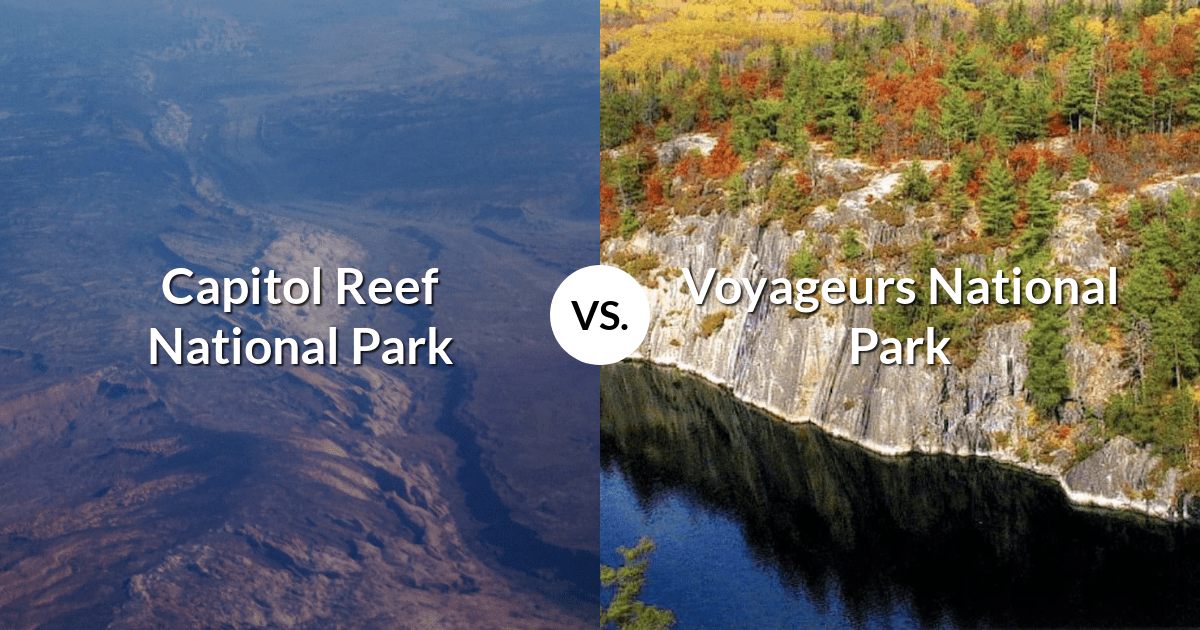Jake Cain is an entrepreneur and writer from Cincinnati, Ohio. He spends his free time driving around the country in his late 90’s conversion van, affectionately known as the “Monster Van” with his wife and 3 boys.
Capitol Reef National Park and Voyageurs National Park are two of America’s most beautiful and diverse national parks, offering visitors a wealth of opportunities to explore and experience the great outdoors. Both parks are unique in their own way, with Capitol Reef offering a stunning landscape of red rock formations and ancient petroglyphs, while Voyageurs offers a breathtaking landscape of crystal-clear lakes and dense forests. Whether you’re looking for a scenic drive, a challenging hike, or a relaxing paddle, both parks have something to offer for everyone. So buckle up and get ready for an adventure, as we take a closer look at Capitol Reef and Voyageurs National Parks, and see what makes them so special.
Hiking Trails in Capitol Reef National Park and Voyageurs National Park
Capitol Reef National Park and Voyageurs National Park both offer a variety of hiking trails, but the types of trails and difficulty levels vary between the two parks.
Capitol Reef National Park, located in southern Utah, is known for its scenic drives and hiking trails that offer stunning views of the park’s rugged landscape. The park’s hiking trails range from easy nature walks to strenuous backcountry hikes. Some of the easiest hikes in the park include the Capitol Gorge Trail, the Rim Overlook Trail, and the Grand Wash Trail. For those seeking a more challenging hike, the park also offers trails such as the Cassidy Arch Trail and the Upper Muley Twist Canyon Trail.
Voyageurs National Park, located in northern Minnesota, is known for its water-based recreational opportunities and hiking trails that offer scenic views of the park’s forests, lakes, and rivers. The park’s hiking trails range from easy nature walks to moderate hikes. Some of the easiest hikes in the park include the Kettle Falls Trail, the Rainy Lake Vista Trail, and the Kabatah Lake Trail. For those seeking a more challenging hike, the park also offers trails such as the Kabetogama Peninsula Trail and the Ash River Trail.
In conclusion, both Capitol Reef National Park and Voyageurs National Park offer a variety of hiking trails, but the types of trails and difficulty levels vary between the two parks. Capitol Reef National Park is known for its scenic drives and hiking trails that offer stunning views of the park’s rugged landscape, while Voyageurs National Park is known for its water-based recreational opportunities and hiking trails that offer scenic views of the park’s forests, lakes, and rivers. Whether you’re seeking an easy nature walk or a challenging hike, both parks offer something for every level of hiker.
Most Popular Hiking Trails in Capitol Reef National Park
| Name | Length | Elevation | Type | Difficulty | Visitor Ratings |
|---|---|---|---|---|---|
| Hickman Bridge Trail | 2735.878 | 129.8448 | Moderate | out and back | 4.5 |
| Cassidy Arch Trail | 4667.086 | 213.9696 | Moderate | out and back | 4.5 |
| Grand Wash Trail via Northeast Trailhead | 7081.096 | 121.92 | Easy | out and back | 4.5 |
| Chimney Rock Loop Trail | 5310.822 | 241.7064 | Moderate | loop | 4.5 |
| Cohab Canyon Trail | 4828.02 | 241.7064 | Moderate | out and back | 4.5 |
| Navajo Knobs Trail | 14001.258 | 650.748 | Hard | out and back | 4.5 |
| Goosenecks & Sunset Point | 4023.35 | 165.8112 | Easy | out and back | 4.5 |
| Capitol Gorge Trail | 7242.03 | 113.9952 | Moderate | out and back | 4 |
| Sulphur Creek Route | 18507.41 | 427.9392 | Easy | out and back | 4.5 |
| Rim Overlook Trail | 6598.294 | 320.9544 | Hard | out and back | 4.5 |
Most Popular Hiking Trails in Voyageurs National Park
| Name | Length | Elevation | Type | Difficulty | Visitor Ratings |
|---|---|---|---|---|---|
| Blind Ash Bay Trail | 5793.624 | 117.9576 | Moderate | out and back | 4 |
| Kabetogama Lake Overlook Trail | 643.736 | 17.9832 | Easy | out and back | 4 |
| Cruiser Lake to Brown Lake and Anderson Bay | 14001.258 | 224.9424 | Moderate | loop | 4 |
| Beaver Pond Overlook Trail | 482.802 | 1.8288 | Easy | out and back | 3.5 |
| Kab-Ash Trail | 24461.968 | 406.908 | Easy | out and back | 3 |
| Sullivan Bay Trail | 2092.142 | 27.7368 | Easy | out and back | 4 |
| Black Bay Beaver Pond Trail | 1931.208 | 22.86 | Easy | out and back | 5 |
Wildlife in Capitol Reef National Park and Voyageurs National Park
Capitol Reef National Park and Voyageurs National Park are both rich in wildlife and offer unique opportunities for wildlife viewing.
At Capitol Reef National Park, visitors can expect to see a variety of mammals, including desert bighorn sheep, mule deer, pronghorns, and coyotes. The park is also home to a variety of birds, including hawks, eagles, and vultures, as well as a diverse array of reptiles, including lizards and snakes. The park’s diverse landscape, ranging from desert to high-altitude forests, supports a wide range of plant species, including cacti, wildflowers, and conifers.
At Voyageurs National Park, visitors can expect to see a variety of mammals, including beavers, otters, and moose, as well as a variety of birds, including loons, ducks, and eagles. The park is also home to a diverse array of fish, including walleye and northern pike, making it a popular destination for fishing. The park’s extensive network of lakes and streams supports a wide range of plant species, including cedar, spruce, and birch.
In conclusion, both Capitol Reef National Park and Voyageurs National Park offer unique opportunities for wildlife viewing, with Capitol Reef National Park offering a diverse range of mammals, birds, and plants in a desert landscape, and Voyageurs National Park offering a variety of mammals, birds, and fish in a water-based environment.
Below are lists of the most commonly spotted wildlife at Capitol Reef National Park and Voyageurs National Park. However, you can see a full list of wildlife at each national park here.
Birds
| Capitol Reef National Park | Voyageurs National Park |
|---|---|
| Peregrine Falcon | Peregrine Falcon |
| Northern Harrier | Northern Harrier |
| Sharp-Shinned Hawk | Sharp-Shinned Hawk |
| Osprey | Osprey |
| Tree Swallow | Tree Swallow |
| Mallard | Mallard |
| Canada Goose | Canada Goose |
| Lincoln’s Sparrow | Lincoln’s Sparrow |
| Ruby-Crowned Kinglet | Ruby-Crowned Kinglet |
| American Robin | American Robin |
| Great Horned Owl | Great Horned Owl |
| Red-Tailed Hawk | Red-Tailed Hawk |
| Northern Flicker | Northern Flicker |
| Merlin | Merlin |
| Barn Swallow | Barn Swallow |
| Savannah Sparrow | Savannah Sparrow |
| Great Blue Heron | Great Blue Heron |
| Hermit Thrush | Hermit Thrush |
| American Kestrel | American Kestrel |
| Bald Eagle | Bald Eagle |
| Song Sparrow | Song Sparrow |
| European Starling | European Starling |
| Northern Pintail | Northern Pintail |
| American Wigeon | American Wigeon |
| Green-Winged Teal | Green-Winged Teal |
Mammals
| Capitol Reef National Park | Voyageurs National Park |
|---|---|
| Coyote | Coyote |
| American Beaver | American Beaver |
| Muskrat | Muskrat |
| Big Brown Bat | Big Brown Bat |
| Bobcat | Bobcat |
| Striped Skunk | Striped Skunk |
| Little Brown Bat | Little Brown Bat |
| Deer Mouse | Deer Mouse |
| Raccoon | Raccoon |
| Black Bear | Black Bear |
| Porcupine | Porcupine |
| Silver-Haired Bat | Silver-Haired Bat |
| Hoary Bat | Hoary Bat |
| Red Fox | Red Fox |
| Long-Tailed Weasel | Long-Tailed Weasel |
| House Mouse | House Mouse |
| Mountain Lion | Mountain Lion |
| American Mink | Mink |
| Mule Deer | Common Gray Fox |
| Common Gray Fox | Plains Wolf |
| Long-Legged Myotis | American Badger |
| Long-Eared Myotis | Ermine |
| American Badger | Snowshoe Hare |
| Ermine | River Otter |
| California Myotis | Masked Shrew |
Fish
| Capitol Reef National Park | Voyageurs National Park |
|---|---|
| Rainbow Trout | Largemouth Bass |
| Brown Trout | Longnose Sucker |
| Bluegill | Green Sunfish |
| Mottled Sculpin | Bluegill |
| Speckled Dace | Fathead Minnow |
| Black Bullhead | Golden Shiner |
| Cutthroat Trout | Lake Trout |
| Northern Pike | |
| Ellpout | |
| Mottled Sculpin | |
| Slimy Sculpin | |
| Longnose Dace | |
| Black Crappie | |
| Black Bullhead | |
| Creek Chub | |
| Brown Bullhead | |
| Smallmouth Bass |
Reptiles
| Capitol Reef National Park | Voyageurs National Park |
|---|---|
| Gophersnake | |
| Terrestrial Gartersnake | |
| Prairie Rattlesnake | |
| Common Sagebrush Lizard | |
| Greater Short-Horned Lizard | |
| Side-Blotched Lizard | |
| Common Kingsnake | |
| Nightsnake | |
| Long-Nosed Leopard Lizard | |
| Striped Whipsnake | |
| Smith’s Black-Headed Snake | |
| Tree Lizard | |
| Western Whiptail | |
| Western Skink | |
| Desert Spiny Lizard |
Amphibians
| Capitol Reef National Park | Voyageurs National Park |
|---|---|
| Northern Leopard Frog | Northern Leopard Frog |
| Tiger Salamander | Wood Frog |
| Woodhouse’s Toad | |
| Red-Spotted Toad | |
| Canyon Treefrog |
Beautiful Landscapes in Capitol Reef National Park and Voyageurs National Park
Capitol Reef National Park and Voyageurs National Park are both known for their stunning landscapes and natural wonders.
At Capitol Reef, visitors can marvel at the park’s iconic red rock formations, including the Waterpocket Fold, a 100-mile long wrinkle in the earth’s crust, and the Capitol Dome, a massive sandstone dome that rises above the surrounding landscape. The park also offers a variety of scenic drives, including the Scenic Drive, which takes visitors through a scenic canyon, and the Cathedral Valley Road, which offers breathtaking views of the park’s towering sandstone formations.
Voyageurs National Park is known for its crystal-clear lakes, dense forests, and stunning vistas. Visitors can explore the park’s interconnected waterways by boat, canoe, or kayak, and enjoy breathtaking views of the park’s rugged wilderness. The park is also home to a variety of scenic overlooks, including the Kabetogama Peninsula Overlook, which offers stunning views of Kabetogama Lake, and the Ash River Overlook, which provides panoramic views of the surrounding landscape.
Both parks offer a wealth of beautiful landscapes and natural wonders for visitors to enjoy. Whether you’re looking for stunning red rock formations, crystal-clear lakes, or breathtaking vistas, both Capitol Reef and Voyageurs National Parks are sure to provide a memorable experience.
Things To-Do and Activities in Capitol Reef National Park and Voyageurs National Park
Capitol Reef National Park and Voyageurs National Park both offer a wide range of activities for visitors to enjoy, but each park has its own unique set of popular activities.
At Capitol Reef National Park, some of the most popular activities include hiking, scenic drives, and exploring the park’s geological formations. Visitors can hike to scenic overlooks, such as the Grand Wash and Hickman Bridge, or explore the park’s canyons, such as the Cathedral Valley. The park’s scenic drives, including the Scenic Drive and the Notom-Bullfrog Road, offer breathtaking views of the park’s towering cliffs and canyons.
At Voyageurs National Park, some of the most popular activities include boating, fishing, and camping. The park’s extensive network of lakes and streams offers excellent opportunities for boating, fishing, and kayaking, and the park’s many campgrounds offer the perfect base for exploring the park’s waterways. Visitors can also hike the park’s trails, including the Kabetogama Peninsula Trail, which offers panoramic views of the park’s lakes and forests.
In conclusion, both Capitol Reef National Park and Voyageurs National Park offer a wide range of activities for visitors to enjoy, with Capitol Reef National Park being popular for its hiking, scenic drives, and geological formations, and Voyageurs National Park being popular for its boating, fishing, and camping opportunities.
Best Time to Visit Capitol Reef National Park and Voyageurs National Park
Capitol Reef National Park and Voyageurs National Park are located in different regions of the country and have distinct seasonal weather patterns that affect the best time of year to visit each park.
Capitol Reef National Park is located in southern Utah and experiences hot summers and cold winters. Summer temperatures can reach into the 90s during the day, while winter temperatures can drop below freezing. The park’s high desert climate can also bring strong winds and thunderstorms, especially in the spring and fall. The best time to visit Capitol Reef National Park is in the spring or fall, when temperatures are mild and the park’s scenic drives and hiking trails are less crowded.
Voyageurs National Park is located in northern Minnesota and experiences cold winters and mild summers. Winter temperatures can drop below zero, while summer temperatures typically remain in the 60s and 70s. The park’s forested climate can bring heavy rains and thunderstorms, especially in the summer months. The best time to visit Voyageurs National Park is in the summer, when the park’s water-based recreational opportunities and hiking trails are open and accessible.
In conclusion, the seasonal weather at Capitol Reef National Park and Voyageurs National Park affects when is the best time of year to visit each park. Capitol Reef National Park’s high desert climate is best visited in the spring or fall, while Voyageurs National Park’s forested climate is best visited in the summer. Whether you’re seeking a scenic drive, a hike, or a water-based adventure, both parks offer something for every season.
Family Friendliness of Capitol Reef National Park and Voyageurs National Park
Capitol Reef National Park and Voyageurs National Park are both family-friendly parks, but each has its own unique features that make it better suited for families with children.
Capitol Reef National Park offers a variety of family-friendly activities, including scenic drives, easy hikes, and ranger-led programs. The park’s scenic drives, including the Scenic Drive and Cathedral Valley Road, offer stunning views of the park’s iconic red rock formations and ancient petroglyphs, and are suitable for families of all ages. The park also offers a variety of easy hikes, such as the Rim Overlook Trail and the Grand Wash Trail, which offer stunning views of the park’s landscape without too much physical exertion.
Voyageurs National Park is also a great option for families, offering a variety of water-based activities, including boating, canoeing, and kayaking. The park’s interconnected waterways provide a unique and exciting way for families to explore the park’s rugged wilderness, and its scenic overlooks offer breathtaking views of the park’s crystal-clear lakes and dense forests. The park also offers ranger-led programs, including guided hikes and boat tours, which provide a fun and educational experience for families.
Both parks offer a wealth of family-friendly activities, but the best park to visit with children will depend on your family’s interests. If your family enjoys scenic drives and easy hikes, Capitol Reef National Park is the better choice. If your family enjoys water-based activities and scenic overlooks, Voyageurs National Park is the way to go. Regardless of your family’s interests, both parks are sure to provide a memorable experience.


